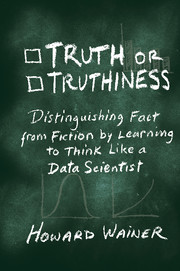Book contents
- Frontmatter
- Dedication
- Contents
- Preface and Acknowledgments
- Introduction
- Section I Thinking Like a Data Scientist
- Section II Communicating Like a Data Scientist
- Section III Applying the Tools of Data Science to Education
- 12 Waiting for Achilles
- 13 How Much Is Tenure Worth?
- 14 Detecting Cheating Badly: If It Could Have Been, It Must Have Been
- 15 When Nothing Is Not Zero: A True Saga of Missing Data, Adequate Yearly Progress, and a Memphis Charter School
- 16 Musing about Changes in the SAT: Is the College Board Getting Rid of the Bulldog?
- 17 For Want of a Nail: Why Worthless Subscores May Be Seriously Impeding the Progress of Western Civilization
- Section IV Conclusion: Don't Try Th is at Home
- Bibliography
- Sources
- Index
14 - Detecting Cheating Badly: If It Could Have Been, It Must Have Been
from Section III - Applying the Tools of Data Science to Education
Published online by Cambridge University Press: 05 December 2015
- Frontmatter
- Dedication
- Contents
- Preface and Acknowledgments
- Introduction
- Section I Thinking Like a Data Scientist
- Section II Communicating Like a Data Scientist
- Section III Applying the Tools of Data Science to Education
- 12 Waiting for Achilles
- 13 How Much Is Tenure Worth?
- 14 Detecting Cheating Badly: If It Could Have Been, It Must Have Been
- 15 When Nothing Is Not Zero: A True Saga of Missing Data, Adequate Yearly Progress, and a Memphis Charter School
- 16 Musing about Changes in the SAT: Is the College Board Getting Rid of the Bulldog?
- 17 For Want of a Nail: Why Worthless Subscores May Be Seriously Impeding the Progress of Western Civilization
- Section IV Conclusion: Don't Try Th is at Home
- Bibliography
- Sources
- Index
Summary
Introduction
My annual retreat in the Adirondack Mountains of upstate New York was interrupted by a phone call from an old friend. It seemed that he was hired as a statistical consultant for an unfortunate young man who had been accused of cheating on a licensing exam. My friend, a fine statistician, felt that he could use a little help on the psychometric aspects of the case. After hearing the details, I agreed to participate. The situation that led to the young man's problem was directly due to fallacies associated with the unprincipled exploratory analyses of big data. The accusers had access to a huge data set from which they drew an unjustified conclusion because they did not consider the likelihood of false positives. As discussed in Chapter 5, we see again how a little thought should precede the rush to calculate.
Fishing for Cheaters
The young man had taken, and passed, a licensing test. It was the third time he took the exam – the first two times he failed by a small amount, but this time he passed, also by a small amount. The licensing agency, as part of their program to root out cheating, did a pro forma analysis in which they calculated the similarity between all pairs of examinees based on the number of incorrect item responses those examinees had in common. For the eleven thousand examinees they calculated this for all sixty million pairs. After completing this analysis, they concluded that forty-six examinees (twenty-three pairs) were much more similar than one would expect by chance. Of these twenty-three pairs, only one took the exam at the same time in the same room, and they sat but one row apart. At this point a more detailed investigation was done in which their actual test booklets were examined. The test booklets were the one place where examinees could do scratch work before deciding on the correct answer. The investigator concluded on the basis of this examination that there was not enough work in the test booklets to allow him to conclude that the examinee had actually done the work, and so reached the decision that the examinee had copied and his score was not earned. His passing score was then disallowed, and he was forbidden from applying to take this exam again for ten years.
- Type
- Chapter
- Information
- Truth or TruthinessDistinguishing Fact from Fiction by Learning to Think Like a Data Scientist, pp. 152 - 160Publisher: Cambridge University PressPrint publication year: 2015



